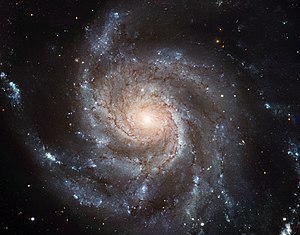Pinwheel Galaxy
| Pinwheel Galaxy | |
|---|---|
 |
|
| Observation data (J2000 epoch) | |
| Constellation | Ursa Major |
| Right ascension | 14h 03m 12.6s |
| Declination | +54° 20′ 57″ |
| Redshift | 0.000804 |
| Helio radial velocity | 241 ± 2 km/s |
| Distance | 20.9 ± 1.8 Mly (6.4 ± 0.5 Mpc) |
| Apparent magnitude (V) | 7.86 |
| Characteristics | |
| Type | SAB(rs)cd |
| Number of stars | 1 trillion (1012) |
| Size | ~170,000 ly in diameter |
| Apparent size (V) | 28′.8 × 26′.9 |
| Other designations | |
| Messier 101, M101, NGC 5457, UGC 8981, PGC 50063, Arp 26 | |
| References: | |
The Pinwheel Galaxy (also known as Messier 101, M101 or NGC 5457) is a face-on spiral galaxy distanced 21 million light-years (six megaparsecs) away from earth in the constellation Ursa Major. First discovered by Pierre Méchain on March 27, 1781, it was communicated to Charles Messier who verified its position for inclusion in the Messier Catalogue as one of its final entries.
On February 28, 2006, NASA and the European Space Agency released a very detailed image of the Pinwheel Galaxy, which was the largest and most detailed image of a galaxy by Hubble Space Telescope at the time. The image was composed from 51 individual exposures, plus some extra ground-based photos.
On August 24, 2011, a Type Ia supernova, SN 2011fe, was discovered in M101.
Pierre Méchain, the discoverer of Messier 101, described it as a "nebula without star, very obscure and pretty large, 6' to 7' in diameter, between the left hand of Bootes and the tail of the great Bear. It is difficult to distinguish when one lits the [grating] wires."
William Herschel noted in 1784 that "[M101] in my 7, 10, and 20-feet [focal length] reflectors shewed a mottled kind of nebulosity, which I shall call resolvable; so that I expect my present telescope will, perhaps, render the stars visible of which I suppose them to be composed."
Lord Rosse observed M101 in his 72-inch diameter Newtonian reflector during the second half of the 19th century. He was the first to make extensive note of the spiral structure and made several sketches.
To observe the spiral structure in modern instruments requires a fairly large instrument, very dark skies, and a low power eyepiece.
M101 is a large galaxy comparable in size to the Milky Way. With a diameter of 170,000 light-years it is roughly equal the size of the Milky Way. It has a disk mass on the order of 100 billion solar masses, along with a small central bulge of about 3 billion solar masses.
...
Wikipedia
